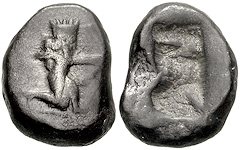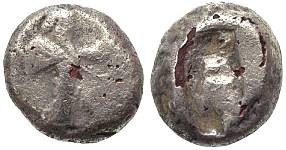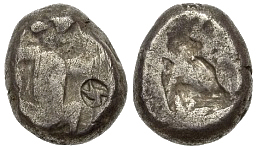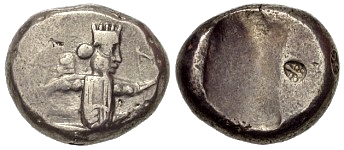Siglos
The coinage of the Achaemenid (Persian) Empire was a continuation of the coins of Lydia. Achaemenid coinage includes the official imperial issues, gold darics and silver sigloi, issued from 520 BCE to 330 BCE, as well as coins issued by the Achaemenid governors (Satraps), such as those stationed in ancient Asia Minor. Types I, II and IIIa were issued with a standard c. 5.40 grams all beginning under Darius I. Before 480 BC, beginning with the issue of Type IIIb, the standard was increased to c. 5.60 grams Purity was at first issue 97-98% but by the middle 4th century was 94-95%. 1 Siglos = 7.5 Attic Obols. Types III and IV may have been issued simultaneously, possibly by different mints. Types III and IV have significant variations in fabric and style and may have been issued by multiple mints.
References
Carradice: | Carradice, Ian. Coinage and Administration in the Athenian and Persian Empires. British Archaeological Reports 343. (Oxford, 1987). |
Carradice NC 1998: | Carradice, Ian. "Two Achaemenid Hoards." in Numismatic Chronicle 158. (Cambridge, 1998). |
Carradice Price: | Carradice, Ian. "The Dinar Hoard of Persian Sigloi" in Studies in Greek Numismatics in Memory of Martin Jessop Price. (London, 1998) |
Klein: | Klein, Dieter. Sammlung von Griechischen Kleinsilbermünzen und Bronzen, Nomismata 3. (Milano, 1999). |
Noe Sigloi: | Noe, Sydney P. Two Hoards of Persian Sigloi. Numismatic Notes and Monographs 136. (New York, 1956) |
SNG Kayhan: | Sylloge Nummorum Graecorum, Turkey 1: The Muharrem Kayhan Collection. (Istanbul, 2002). |
Rosen: | Waggoner, N. M. Early Greek Coins from the Collection of Jonathan P. Rosen (ANS ACNAC 5). (New York, 1983). |
Asyut: | Price, M.J. & N. Waggoner. Archaic Greek Coinage. The Asyut Hoard. (London, 1975) |
Sigloi Types
Type| I. Darius I, c. 520 - 505 BC. c. 5.30 - 5.39 g.
Half length figure of the Great King right, crowned, two arrows in right, bow in left, bearded, crowned.
Siglos. Carradice type I, plate XI, 10; BMC Arabia, p. 175, 196 ff.; SGCV II 3427; Klein 753 (510 - 486 BC); Noe Sigloi pl. XIV, 473 ff.; Carradice NC 1998 pl. 3, 52 - 57; SNG Kayhan -, Rosen -. Very rare.
1/24 Siglos. Carradice type| I; Klein 759 (0.20 g). Very rare.
Type| II. Darius I, c. 505 - 486 BC. c. 5.30 - 5.39 g.
Kneeling-running figure of the Great King right, drawing bow, bearded, crowned, quiver at shoulder.
Siglos. Carradice type II, plate XI, 11 - 13; BMC Arabia p. 173, 185 ff.; SGCV II 3428; Klein 754; Noe Sigloi pl. XIII, 215 ff.; Carradice NC 1998 pl. 3, 58 ff. Rare.
1/2 Siglos. Rosen 669 (3.658 g). Very rare.
1/3 Siglos. Carradice type| II; SGCV II 3429, SNG Kayhan 1027 (1.78 g), Klein 755 (1.71 g). Rare.
1/4 Siglos. Carradice type| II; Klein 756 (1.36 g). Very rare.
1/12 Siglos. Carradice type| II; SNG Kayhan 1028 (0.45g), Klein 757 (0.44 g). Very rare.
1/32 Siglos. Carradice type| II; Klein 760 (0.14 g). Very rare.
Type| III. Darius I - Artaxerxes II, c. 490 - 375 BC.
Kneeling-running figure of the Great King right, transverse spear with point downward in right, bow in left, bearded, crowned.
Type| IIIa. Darius I - Xerxes I, c. 490 - 480 BC. c. 5.30 - 5.39 g.
Lighter weight standard, c. 5.30 - 5.39 g, is the most important distinction from Type IIIb but it is difficult to determine intended weight with wear.
Usually two pellets behind beard, generally a life-like well proportioned figure, V-shaped folds on front of drapery, long beard with flat end, quiver visible.
Siglos. Carradice type| IIIa, plate XI, 14 - 15; BMC Arabia, p. 155, 57 and pl XXV, 11; SGCV II 4678; Carradice NC 1998 pl. 5, 107 ff. and pl. 8, 1 - 4; Rosen -; SNG Kayhan -. Rare.
Siglos, IIIa style, light standard, without pellets. Carradice type IIIa?; Carradice NC 1998, pl. 8, 5 - 16.There may have been two mints, one issuing with the two pellets and one without. Most or possibly all light weight examples without pellets are type IIIb.
Type| IIIb (early). Xerxes I - Darius II, c. 485 - 420 BC. c. 5.55 - 5.60 g.
Drapery with naturalistic fold over the advanced left knee, no pellets, sometimes appears beardless, often cartoon-like or crude, sometimes an elongated face, sometimes quiver not visible, significant variation in style.
Siglos. Carradice type| IIIb (early), plate XII, 16 ff.; Klein 761 (485 - 470 BC); SNG Kayhan 1030; Rosen 673; SGCV II 4682; Carradice NC 1998 pl. 7, 155 ff.; Carradice Price p. 67 and pl. 7, 1 ff.
Siglos, plated counterfeit. Carradice type| IIIb (early); cf. Klein 761; SNG Kayhan 1030; Rosen 673; SGCV II 4682 (all official)Carradice NC 1998 discusses two styles, each with three subtypes. Style A has a stocky figure usually with a large square ended beard. Style B has a slimmer figure, often with a cartoon-like large eye and aquiline nose, and sometimes a beard composed of curved or vertical lines. Significant differences in style often indicate a type was struck at more than one mint, however, both styles share reverse dies. Type IIIb might have been struck at more than one mint, but it remains unproven.
Type| IIIb (late). Artaxerxes I - Artaxerxes II, c. 425 - 375 BC. c. 5.55 - 5.60 g.
Stylistic drapery with broad semi-circular sweep of folds from the left knee back to the right heel, no pellets, large formal figure, often V-shaped folds on front of drapery, sometimes quiver not visible.
Siglos. Carradice type| IIIb (late), plate XIV, 36 ff.; SNG Kayhan 1039; Rosen 671 - 672; SGCV II 4682; Carradice Price p. 69 and pl. 7, 79 ff.
1/8 Siglos. Klein 762 (0.68 g, 485 - 470 BC). Rare.
Type| IV. Artaxerxes I - Darius III, c. 455 - 340 B.C.
Kneeling-running figure of the Great King right, dagger in right, bow in left, bearded, crowned.
Siglos. Carradice type| IV; SGCV II 4683; BMC Arabia p. 165, 125 ff.; SNG Kahan 1033 ff., Rosen 674 ff.
Siglos, plated counterfeit. Carradice type| IV; SNG Kayhan 1034 (4.29 g); cf. SGCV II 4683 (official)
1/4 Siglos. Carradice type| IV; Klein 764 (1.26 g); BMC Arabia p. 167, 143, pl. XXVI, 27; SNG Kayhan 1041; Rosen 679. Rare.
1/8 Siglos. Carradice type| IV; Klein 765 (0.62 g)

1/24 Siglos. Carradice type| IV; unpublished, cf. Klein 759 (1/24 Siglos, Carradice type| I) and Klein 765 (1/8 Siglos, Carradice type| IV)
Type| IV (early) A. Artaxerxes I - Darius II, c. 455 - 420 BC. c. 5.55 - 5.60 g.
Stiff figure, shapeless body completely lacking a waist, often cartoon-like, sometimes pellets on arms, sometimes appears beardless, dotted exergue line, sometimes a symbol in reverse| incuse|.
Siglos, no symbol. Carradice type IV| (early) A; Carradice Price p. 71 and pl. 19, 146 ff.; SGCV II 4683
Siglos, helmet facing within reverse incuse. Carradice type| IV A, plate XIII, 34; BMC Arabia p. 165, 124, pl. XXVI, 21
Siglos, lion head left roaring with open mouth within reverse incuse. Carradice type| IV A; plate XIII, 35; BMC Arabia p. 163, 110 ff., pl. XXVI, 10 ff.
Siglos, incuse lion head right within reverse incuse. Carradice type| IV A; BMC Arabia p. 164, 118 - 119, pl. XXVI, 15 - 16
Siglos, stylised facing lion's head within reverse incuse. Carradice type| IV A; BMC Arabia p. 164, 120 - 121, pl. XXVI, 17 - 18
Siglos, stylised facing lion's head resembling palmette within reverse incuse. Carradice type| IV A; BMC Arabia p. 165, 122 - 123, pl. XXVI 19 - 20
Type| IV (middle) B. Darius II - Artaxerxes II, c. 420 - 375 BC. c. 5.55 - 5.60 g.
Stylistic formal figure, waist indicated, often pellets on sleeves, large eye, short beard, sometimes no quiver visible, dotted or plain exergue line.
Siglos. Carradice type| IV (middle) B; Carradice Price p. 73 and pl. 19, 217 ff.; SNG Kayhan 1033; SGCV II 4683Carradice Price makes the distinction between Type IV (early) A and Type IV (middle) B. Distinguishing between the two types is challenging. The earliest coins of Type| IV B are similar to type A and the latest are closer to type C. BMC Arabia breaks down Type IV into groups that do not appear to correspond to Carradice A, B and C. Dealer catalogs and online listings with the same styles identified as variously as styles A, B and C (sometimes appearing to be labled at random) indicate confusion is shared by some other experienced numismatists. Coins are sometimes attributed as Carradice Type| IV A/B, Artaxerxes I - Artaxerxes II, c. 455 - 375 B.C.
Type| IV (late) C. Artaxerxes II - Darius III, c. 375 - 340 BC.
Attractive formal regal figure, three or four annulets or pellets on chest, neat style, large head, long beard, usually v-shaped folds on front of kandys, usually stylistic drapery with broad semi-circular sweep of folds from the left knee back to the right heel, plain exergue line.
Siglos. Carradice type| IV (late), plate XV, 46 ff.; BMC Arabia (Group E) p. 171, 172 ff., pl. XXVII, 18 - 19; SNG Kayhan 1031; SGCV II 4683; Rosen 674 - 675, Klein 763; Carradice Price p. 77 and pl. 20, 387 ff.; Klein -
Siglos
The coinage of the Achaemenid (Persian) Empire was a continuation of the coins of Lydia. Achaemenid coinage includes the official imperial issues, gold darics and silver sigloi, issued from 520 BCE to 330 BCE, as well as coins issued by the Achaemenid governors (Satraps), such as those stationed in ancient Asia Minor. Types I, II and IIIa were issued with a standard c. 5.40 grams all beginning under Darius I. Before 480 BC, beginning with the issue of Type IIIb, the standard was increased to c. 5.60 grams Purity was at first issue 97-98% but by the middle 4th century was 94-95%. 1 Siglos = 7.5 Attic Obols. Types III and IV may have been issued simultaneously, possibly by different mints. Types III and IV have significant variations in fabric and style and may have been issued by multiple mints.
References
Carradice: | Carradice, Ian. Coinage and Administration in the Athenian and Persian Empires. British Archaeological Reports 343. (Oxford, 1987). |
Carradice NC 1998: | Carradice, Ian. "Two Achaemenid Hoards." in Numismatic Chronicle 158. (Cambridge, 1998). |
Carradice Price: | Carradice, Ian. "The Dinar Hoard of Persian Sigloi" in Studies in Greek Numismatics in Memory of Martin Jessop Price. (London, 1998) |
Klein: | Klein, Dieter. Sammlung von Griechischen Kleinsilbermünzen und Bronzen, Nomismata 3. (Milano, 1999). |
Noe Sigloi: | Noe, Sydney P. Two Hoards of Persian Sigloi. Numismatic Notes and Monographs 136. (New York, 1956) |
SNG Kayhan: | Sylloge Nummorum Graecorum, Turkey 1: The Muharrem Kayhan Collection. (Istanbul, 2002). |
Rosen: | Waggoner, N. M. Early Greek Coins from the Collection of Jonathan P. Rosen (ANS ACNAC 5). (New York, 1983). |
Asyut: | Price, M.J. & N. Waggoner. Archaic Greek Coinage. The Asyut Hoard. (London, 1975) |
Sigloi Types
Type| I. Darius I, c. 520 - 505 BC. c. 5.30 - 5.39 g.
Half length figure of the Great King right, crowned, two arrows in right, bow in left, bearded, crowned.
Siglos. Carradice type I, plate XI, 10; BMC Arabia, p. 175, 196 ff.; SGCV II 3427; Klein 753 (510 - 486 BC); Noe Sigloi pl. XIV, 473 ff.; Carradice NC 1998 pl. 3, 52 - 57; SNG Kayhan -, Rosen -. Very rare.
1/24 Siglos. Carradice type| I; Klein 759 (0.20 g). Very rare.
Type| II. Darius I, c. 505 - 486 BC. c. 5.30 - 5.39 g.
Kneeling-running figure of the Great King right, drawing bow, bearded, crowned, quiver at shoulder.
Siglos. Carradice type II, plate XI, 11 - 13; BMC Arabia p. 173, 185 ff.; SGCV II 3428; Klein 754; Noe Sigloi pl. XIII, 215 ff.; Carradice NC 1998 pl. 3, 58 ff. Rare.
1/2 Siglos. Rosen 669 (3.658 g). Very rare.
1/3 Siglos. Carradice type| II; SGCV II 3429, SNG Kayhan 1027 (1.78 g), Klein 755 (1.71 g). Rare.
1/4 Siglos. Carradice type| II; Klein 756 (1.36 g). Very rare.
1/12 Siglos. Carradice type| II; SNG Kayhan 1028 (0.45g), Klein 757 (0.44 g). Very rare.
1/32 Siglos. Carradice type| II; Klein 760 (0.14 g). Very rare.
Type| III. Darius I - Artaxerxes II, c. 490 - 375 BC.
Kneeling-running figure of the Great King right, transverse spear with point downward in right, bow in left, bearded, crowned.
Type| IIIa. Darius I - Xerxes I, c. 490 - 480 BC. c. 5.30 - 5.39 g.
Lighter weight standard, c. 5.30 - 5.39 g, is the most important distinction from Type IIIb but it is difficult to determine intended weight with wear.
Usually two pellets behind beard, generally a life-like well proportioned figure, V-shaped folds on front of drapery, long beard with flat end, quiver visible.
Siglos. Carradice type| IIIa, plate XI, 14 - 15; BMC Arabia, p. 155, 57 and pl XXV, 11; SGCV II 4678; Carradice NC 1998 pl. 5, 107 ff. and pl. 8, 1 - 4; Rosen -; SNG Kayhan -. Rare.
Siglos, IIIa style, light standard, without pellets. Carradice type IIIa?; Carradice NC 1998, pl. 8, 5 - 16.There may have been two mints, one issuing with the two pellets and one without. Most or possibly all light weight examples without pellets are type IIIb.
Type| IIIb (early). Xerxes I - Darius II, c. 485 - 420 BC. c. 5.55 - 5.60 g.
Drapery with naturalistic fold over the advanced left knee, no pellets, sometimes appears beardless, often cartoon-like or crude, sometimes an elongated face, sometimes quiver not visible, significant variation in style.
Siglos. Carradice type| IIIb (early), plate XII, 16 ff.; SNG Kayhan 1030; Rosen 673; SGCV II 4682; Carradice NC 1998 pl. 7, 155 ff.; Carradice Price p. 67 and pl. 7, 1 ff.
Siglos, plated counterfeit. Carradice type| IIIb (early); cf. Klein 761; SNG Kayhan 1030; Rosen 673; SGCV II 4682 (all official)Carradice NC 1998 discusses two styles, each with three subtypes. Style A has a stocky figure usually with a large square ended beard. Style B has a slimmer figure, often with a cartoon-like large eye and aquiline nose, and sometimes a beard composed of curved or vertical lines. Significant differences in style often indicate a type was struck at more than one mint, however, both styles share reverse dies. Type IIIb might have been struck at more than one mint, but it remains unproven. Klein dates Type IIIb early 485 - 470 BC.
Type| IIIb (late). Artaxerxes I - Artaxerxes II, c. 425 - 375 BC. c. 5.55 - 5.60 g.
Stylistic drapery with broad semi-circular sweep of folds from the left knee back to the right heel, no pellets, large formal figure, often V-shaped folds on front of drapery, sometimes quiver not visible.
Siglos. Carradice type| IIIb (late), plate XIV, 36 ff.; SNG Kayhan 1039; Rosen 671 - 672; SGCV II 4682; Carradice Price p. 69 and pl. 7, 79 ff.
1/8 Siglos. Klein 762 (0.68 g, 485 - 470 BC). Rare.
Type| IV. Artaxerxes I - Darius III, c. 455 - 340 B.C.
Kneeling-running figure of the Great King right, dagger in right, bow in left, bearded, crowned.
Siglos. Carradice type| IV; SGCV II 4683; BMC Arabia p. 165, 125 ff.; SNG Kahan 1033 ff., Rosen 674 ff.
Siglos, plated counterfeit. Carradice type| IV; SNG Kayhan 1034 (4.29 g); cf. SGCV II 4683 (official)
1/4 Siglos. Carradice type| IV; Klein 764 (1.26 g); BMC Arabia p. 167, 143, pl. XXVI, 27; SNG Kayhan 1041; Rosen 679. Rare.
1/8 Siglos. Carradice type| IV; Klein 765 (0.62 g)

1/24 Siglos. Carradice type| IV; unpublished, cf. Klein 759 (1/24 Siglos, Carradice type| I) and Klein 765 (1/8 Siglos, Carradice type| IV)
Type| IV (early) A. Artaxerxes I - Darius II, c. 455 - 420 BC. c. 5.55 - 5.60 g.
Stiff figure, shapeless body completely lacking a waist, often cartoon-like, sometimes pellets on arms, sometimes appears beardless, dotted exergue line, sometimes a symbol in reverse| incuse|.
Siglos, no symbol. Carradice type IV| (early) A; Carradice Price p. 71 and pl. 19, 146 ff.; SGCV II 4683
Siglos, helmet facing within reverse incuse. Carradice type| IV A, plate XIII, 34; BMC Arabia p. 165, 124, pl. XXVI, 21
Siglos, lion head left roaring with open mouth within reverse incuse. Carradice type| IV A; plate XIII, 35; BMC Arabia p. 163, 110 ff., pl. XXVI, 10 ff.
Siglos, incuse lion head right within reverse incuse. Carradice type| IV A; BMC Arabia p. 164, 118 - 119, pl. XXVI, 15 - 16
Siglos, stylised facing lion's head within reverse incuse. Carradice type| IV A; BMC Arabia p. 164, 120 - 121, pl. XXVI, 17 - 18
Siglos, stylised facing lion's head resembling palmette within reverse incuse. Carradice type| IV A; BMC Arabia p. 165, 122 - 123, pl. XXVI 19 - 20
Type| IV (middle) B. Darius II - Artaxerxes II, c. 420 - 375 BC. c. 5.55 - 5.60 g.
Stylistic formal figure, waist indicated, often pellets on sleeves, large eye, short beard, sometimes no quiver visible, dotted or plain exergue line.
Siglos. Carradice type| IV (middle) B; Carradice Price p. 73 and pl. 19, 217 ff.; SNG Kayhan 1033; SGCV II 4683Carradice Price makes the distinction between Type IV (early) A and Type IV (middle) B. Distinguishing between the two types is challenging. The earliest coins of Type| IV B are similar to type A and the latest are closer to type C. BMC Arabia breaks down Type IV into groups that do not appear to correspond to Carradice A, B and C. Dealer catalogs and online listings with the same styles identified as variously as styles A, B and C (sometimes appearing to be labled at random) indicate confusion is shared by some other experienced numismatists. Coins are sometimes attributed as Carradice Type| IV A/B, Artaxerxes I - Artaxerxes II, c. 455 - 375 B.C.
Type| IV (late) C. Artaxerxes II - Darius III, c. 375 - 340 BC.
Attractive formal regal figure, three or four annulets or pellets on chest, neat style, large head, long beard, usually v-shaped folds on front of kandys, usually stylistic drapery with broad semi-circular sweep of folds from the left knee back to the right heel, plain exergue line.
Siglos. Carradice type| IV (late), plate XV, 46 ff.; BMC Arabia (Group E) p. 171, 172 ff., pl. XXVII, 18 - 19; SNG Kayhan 1031; SGCV II 4683; Rosen 674 - 675, Klein 763; Carradice Price p. 77 and pl. 20, 387 ff.; Klein -
































